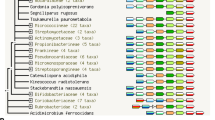Abstract
The effects of PLC and Pkc inhibitors on Aspergillus nidulans depend on the carbon source. PLC inhibitors Spm and C48/80 delayed the first nuclear division in cultures growing on glucose, but stimulated it in media supplemented with pectin. Less intense were these effects on the mutant transformed with PLC-A gene rupture (AP27). Neomycin also delayed the germination in cultures growing on glucose or pectin; however, on glucose, the nuclear division was inhibited whereas in pectin it was stimulated. These effects were minor in AP27. The effects of Ro-31-8425 and BIM (both Pkc inhibitors) were also opposite for cultures growing on glucose or pectin. On glucose cultures of both strains BIM delayed germination and the first nuclear division, whereas on pectin both parameters were stimulated. Opposite effects were also detected when the cultures were growing on glucose or pectin in the presence of Ro-31-8425.
Similar content being viewed by others
Abbreviations
- BIM:
-
bisindolylmaleimide
- C48/80:
-
compound 48/80
- CM:
-
complete medium
- DAG:
-
di-O-acylglycerol
- DAPI:
-
4′,6-diamidino-2-phenylindole
- DMSO:
-
dimethylsulfoxide
- IP3 :
-
myo-inositol 1,4,5-triphosphate
- MM:
-
minimal medium
- Neo:
-
neomycin
- PBS:
-
phosphate-buffered saline
- PI3K:
-
phosphoinositide 3-kinase
- PIP:
-
phosphatidylinositol 4-phosphate
- PIP2 :
-
phosphatidylinositol 4,5-bisphos
- PI-PLC:
-
phosphoinositide-specific phospholipase C
- Pkc(s):
-
protein kinase(s) C (EC 2.7.11.13)
- PkcA:
-
protein kinase C of A. nidulans
- PkcB:
-
see text
- pkcA, pkcB:
-
see text
- PLC:
-
phospholipase C (EC 3.1.4.3)
- Ro-31-8425:
-
2-[8-(aminomethyl)-6,7,8,9-tetrahydropyrido-[1,2-a]-indol-3-yl]-3-(1-methyl-1H-indol-3-yl)maleimide
- Spm:
-
spermine (5,10-diazadodecane-1,12-diamine)
References
Ambra R., Macino G.: Cloning and characterization of Pkc-homologous genes in the truffle species Tuber borchii and Tuber magnatum. FEMS Microbiol.Lett.189, 45–53 (2000).
Azzi A., Boscoboinik D., Hensey C.: The protein kinase C family. Eur.J.Biochem.208, 547–557 (1992).
Berridge M.: Inositol triphosphate and calcium signalling. Nature361, 315–325 (1993).
Echevarría-machado I., Muñoz-sánchez A., Loyola-vargas V.M., Hernández-sotomayor S.M.T.: Spermine stimulation of phospholipase C from Catharanthus roseus transformed roots. J.Plant Physiol.159, 1179–1188 (2002).
Echevarría-machado I., Ramos-díaz A., Brito-argáez L., Racagni-di Palma G., Loyola-vargas V.M., Hernández-sotomayor S.M.T.: Polyamines modify the components of phospholipids-based signal transduction pathway in Coffea arabica L. cells. Plant Physiol.Biochem.43, 874–881 (2005).
Fruman D.A., Meyers R.E., Cantley L.C.: Phosphoinositide kinases. Ann.Rev.Biochem.67, 481–507 (1998).
Gavric O., Dos Santos D.B., Griffiths A.: Mutation and divergence of the phospholipase C gene in Neurospora crassa. Fungal Gen. Biol.44, 242–249 (2007).
Harris S.D.: The duplication cycle in Aspergillus nidulans. Fungal Genet.Biol.22, 1–12 (1997).
Harris S.D., Read N.D., Roberson R.W., Shaw B., Seiler S., Plamann M., Momany M.: Polarisome meets spitzenkärper: microscopy, genetics, and genomics converge. Eukaryot.Cell4, 225–229 (2005).
Herrmann M., Sprote P., Brakhage A.A.: Protein kinase C (PkcA) of Aspergillus nidulans is involved in penicillin production. Appl.Environ.Microbiol.72, 2957–2970 (2006).
Heung L.J., Luberto C., Plowden A., Hannun Y.A., del Poeta M.: The sphingolipid pathway regulates Pkc1 through the formation of diacylglycerol in Cryptococcus neoformans. J.Biol.Chem.279, 21144–21153 (2004).
Igarashi K., Kashiwagi K.: Polyamines: mysterious modulators of cellular functions. Biochem.Biophys.Res.Commun.271, 559–564 (2000).
Käfer E.: Meiotic and mitotic recombination in Aspergillus and its chromosomal aberrations. Adv.Genet.19, 33–131 (1977).
Lemmon M.A.: Phosphoinositide recognition domains. Traffic4, 201–213 (2003).
Mitchell R.H.: Inositol lipids in cellular signaling mechanisms. Trends Biochem.Sci.17, 274–276 (1992).
Müller C., Spohr A.B., Nielsen J.: Role of substrate concentration in mitosis and hyphal extension of Aspergillus. Biotechnol.Bioeng.67, 390–397 (2000).
Nishizuka Y.: Intracellular signaling by hydrolysis of phospholipids and activation of protein kinase C. Science258, 607–614 (1992).
Ronen R., Sharon H., Levdansky E., Romano J., Shadkchan Y., Osherov N.: The Aspergillus nidulans pkcA gene is involved in polarized growth, morphogenesis and maintenance of cell wall integrity. Curr.Genet.51, 321–329 (2007).
Silverman-gavrila L.B., Lew R.R.: Regulation of the tip-high [Ca2+] gradient in growing hyphae of the fungus Neurospora crassa. Eur.J.Cell Biol.80, 379–390 (2001).
Takenawa T., Itoh T.: Phosphoinositides, key molecules for regulation of actin cytoskeletal organization and membrane traffic from the plasma membrane. Biochim.Biophys.Acta1533, 190–206 (2001).
Teepe A.G., Loprete D.M., He Z., Hoggard T.A., Hill T.W.: The protein kinase C orthologue PkcA plays a role in cell wall integrity and polarized growth in Aspergillus nidulans. Fungal Gen.Biol.44, 554–562 (2007).
Toullec D., Pianetti P., Coste H., Bellevergue P., Grand-perret T., Ajakane M., Baudet V., Boissin P., Boursier E., Loriolle F., Duhamel L., Charon D., Kirilovsky J.: The bisindolylmaleimide GF 109203X is a potent and selective inhibitor of protein kinase C. J.Biol.Chem.266, 15771–15781 (1991).
Tuckwell D., Lavens S.E., Birch M.: Two families of extracellular phospholipase C genes are present in aspergilli. Mycol.Res.110, 1140–1151 (2006).
Vanzela A.P.F.C., Said S.: Evidence for carbon source regulated protein kinase A and protein kinase C signaling in the duplication cycle, polarization and septum formation in Aspergillus nidulans. Microbiol.Res.157, 239–247 (2002).
Vanzela A.P.F.C.: Response of the nuclear duplication cycle and cytokinesis to recognition of carbon source in Aspergillus nidulans. PhD Thesis, p. 165. Brazil São Paulo University 2003.
Author information
Authors and Affiliations
Corresponding author
Rights and permissions
About this article
Cite this article
Chellegatti, M.A.S.C., Yuvamoto, P.D. & Said, S. Role of phospholipase C and protein kinase C in Aspergillus nidulans during growth on pectin or glucose: Effects on germination and duplication cycle. Folia Microbiol 55, 228–232 (2010). https://doi.org/10.1007/s12223-010-0033-6
Received:
Revised:
Published:
Issue Date:
DOI: https://doi.org/10.1007/s12223-010-0033-6



